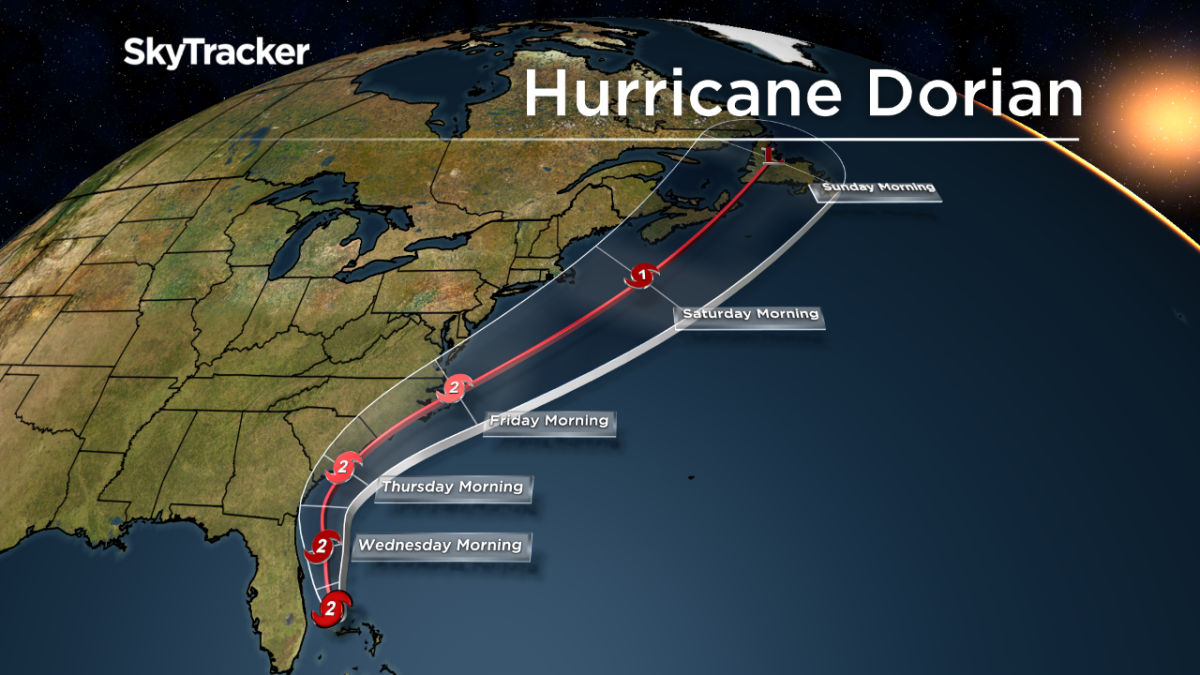Storm surge is expected to reach record highs across certain parts of the United States before hurricane Dorian makes its way to Atlantic Canada over the weekend.

The National Hurricane Center (NHC) issued a storm surge warning that covered the whole length of the coasts of Georgia, South Carolina and North Carolina and extending to Hampton Roads in southern Virginia.
What is storm surge?
Storm surge, an abnormal rise in water levels above expected levels, is often considered the “greatest threat to life and property” from a hurricane, the NHC states in a document.
WATCH: Hurricane Dorian: North Carolina governor says storm will ‘unleash it’s fury’ on the state

Storm surge along the U.S. coast is predicted to reach a peak of 10 feet (3.1 metres) and reached between 12 to 18 feet (up to 5.5 metres) in the Bahamas earlier this week. According to the NHC, a storm surge of 23 feet (seven metres) can inundate the majority of interstates and arterials, almost half of rail mines, 29 airports and all ports in the Gulf Coast area of the United States.
At least 1,500 people lost their lives during Katrina, many of which occurred directly or indirectly as a result of storm surge, the document read.

Get breaking National news
Storm surge often causes significant flooding if residents are ill-prepared, states a University of Illinois research document.
Where and when will storm surge hit?
According to the NHC, storm surge could reach between eight and ten feet in some areas of North Carolina (2.4 to 3.1 metres), with levels ranging from two to seven feet (0.6 metres to 2.1 metres) in other coastal cities. The NHC described these levels as life-threatening and warned civilians to take precautions.
On Thursday, the storm threatened to inundate low-lying coasts from Georgia to Virginia with deadly storm surge.
In Charleston’s downtown, stores and restaurants were boarded up with wood and corrugated metal and about 830,000 people were under mandatory evacuation orders on the South Carolina coast.
A flood chart posted by the National Weather Service projected storm surge alone of up to eight feet (2.4 metres) and a combined high tide and storm surge around Charleston Harbor of 10.3 feet (3.1 metres). The NHC says large and destructive waves up to 8 feet high could be seen in Myrtle Beach if peak surge happens during high tide.
The record, 12.5 feet (4 metres), was set by Hugo in 1989.
“It looks like the storm will get to Cape Fear and north of Cape Fear right about the time of high tide,” Rick Luettich, the director of the Institute of Marine Sciences at UNC Chapel Hill in Morehead City, told North Carolina Public Radio. “Those are areas where the storm surge is apt to cause inland flooding and substantial erosion, perhaps erosion of the dunes.”
This past week, Dorian killed one person in Puerto Rico before hovering over the Bahamas for two days with torrential rains and fierce winds that whipped up 12-18 foot (3.7- to 5.5-meter) storm surges in places.
Will Dorian’s storm surge hit Canada?
Furthermore, the Canadian Hurricane Centre says hurricane Dorian is expected to severely impact parts of the Atlantic provinces this weekend.
It says the most likely track projection brings Dorian south of the Maritimes on Saturday, pushing through eastern Nova Scotia late in the day.
The forecast calls for severe winds and rainfall to have major impacts for southeastern New Brunswick, P.E.I., Nova Scotia, western Newfoundland and Quebec’s Lower North Shore with a chance of a storm surge that may affect parts of Nova Scotia and Newfoundland.
According to data from the Center for Emergency Risk Assessment, the storm is set to reach Atlantic Canada this Saturday with rates of storm surge predicted to reach between four and eight feet (2.1 metres and 2.4 metres) in some areas, though much of Atlantic Canada maintains a low risk of damaging storm surge.
— With files from the Associated Press and Reuters.











Comments